Can cat have peanut butter? Yes, cats technically can — but they really shouldn’t. Peanut butter isn’t toxic in small amounts, but it adds no nutritional value to your cat’s diet and comes with multiple risks. From excess fat and salt to potentially life-threatening ingredients like xylitol, this popular spread is far from an ideal cat treat.
So why do some cats seem fascinated by peanut butter while others won’t touch it? And more importantly, what actually happens if your cat eats it? Let’s explore the science, the risks, and even some real-life experiences from cat owners.
Why Peanut Butter Isn’t a Good Treat for Cats
At first glance, peanut butter seems harmless. It’s creamy, protein-packed, and a favorite for dogs. But cats are very different.
- Cats are obligate carnivores. Their bodies are built to digest meat, not legumes or processed spreads.
- No nutritional benefits. Unlike meat-based treats, peanut butter doesn’t provide taurine or other essential nutrients cats need.
- High in fat and calories. Most cats, especially indoor ones, already struggle with weight gain. A spoonful of peanut butter can easily push them over their daily calorie limit.
👉 Think of it this way: just as cookies might be tasty for us but aren’t healthy, peanut butter is the same for cats.
Risky Ingredients in Peanut Butter
Not all peanut butter is created equal. Beyond peanuts, most store-bought brands include additives that are dangerous for cats.
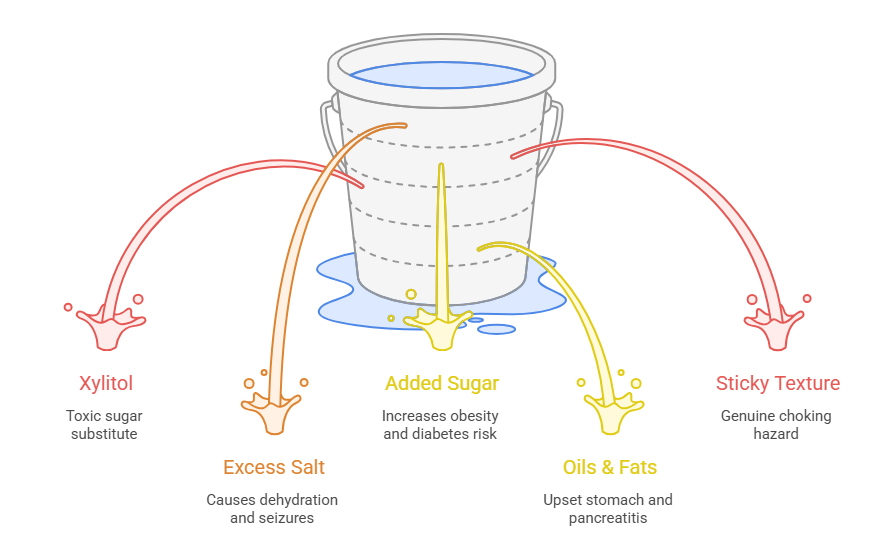
- Xylitol
- A sugar substitute found in “sugar-free” peanut butters.
- Extremely toxic — can cause vomiting, seizures, liver failure, or even death.
- Always check the label; other names include birch sugar or wood sugar.
- Salt
- Excess sodium can lead to dehydration, high blood pressure, and in severe cases, seizures.
- Sugar
- Raises the risk of obesity and diabetes in cats.
- Cats don’t even taste sweetness, so it’s just empty calories.
- Oils & Added Fats
- Too much fat can cause digestive upset or pancreatitis.
- Even “natural” peanut butter is calorie dense.
- Sticky Texture
- Thick, sticky peanut butter can get lodged in a cat’s throat.
- This makes it a genuine choking hazard.
What Happens If a Cat Eats Peanut Butter?
Accidents happen — maybe you dropped a piece of toast, and your curious cat licked it. What should you do?
- Tiny amount, no xylitol: Usually safe, but may cause mild stomach upset. Monitor your cat for vomiting, diarrhea, or loss of appetite.
- Larger portion: Risk of choking, digestive upset, or excess calorie intake.
- Contains xylitol: This is an emergency. Contact your veterinarian or an animal poison control hotline immediately.
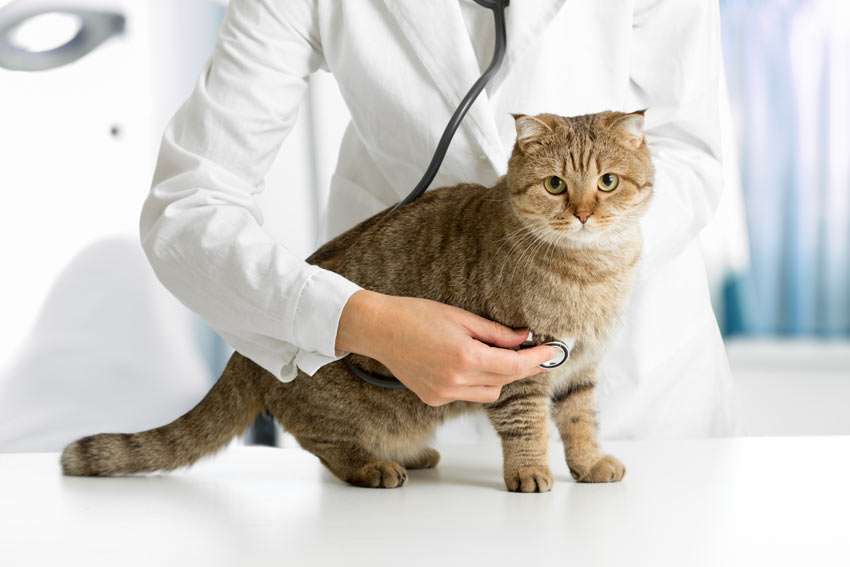
You may also like: Best Cat Treats for Happy & Healthy Cats
A Personal Experience
When my cat was younger, he would sit next to my mom every morning as she ate peanut butter on toast. If given a small piece, he would lick it happily — clearly enjoying the creamy texture. His sister, however, wanted nothing to do with it.
This taught me two things:
- Cats have individual preferences just like people.
- Just because they like it doesn’t mean it’s good for them.
That early lesson is why I now avoid giving peanut butter to my cats, no matter how curious they look.
Why Do Some Pet Parents Give Cats Peanut Butter?
If peanut butter is risky, why do some cat owners still offer it? There are a few common reasons:
- To Hide Medicine: Peanut butter’s sticky texture makes it easier to disguise pills. This trick works well for dogs, so some pet parents try it with cats.
- As a Treat: Some cats appear fascinated by the smell or taste, even though most don’t have a sweet tooth.
- Curiosity: Cats are naturally nosy. If they see you enjoying peanut butter, they may want a taste too.
👉 But here’s the catch: while it may seem like a harmless indulgence, the long-term health risks far outweigh the short-term convenience.
How Much Peanut Butter Is “Safe”?
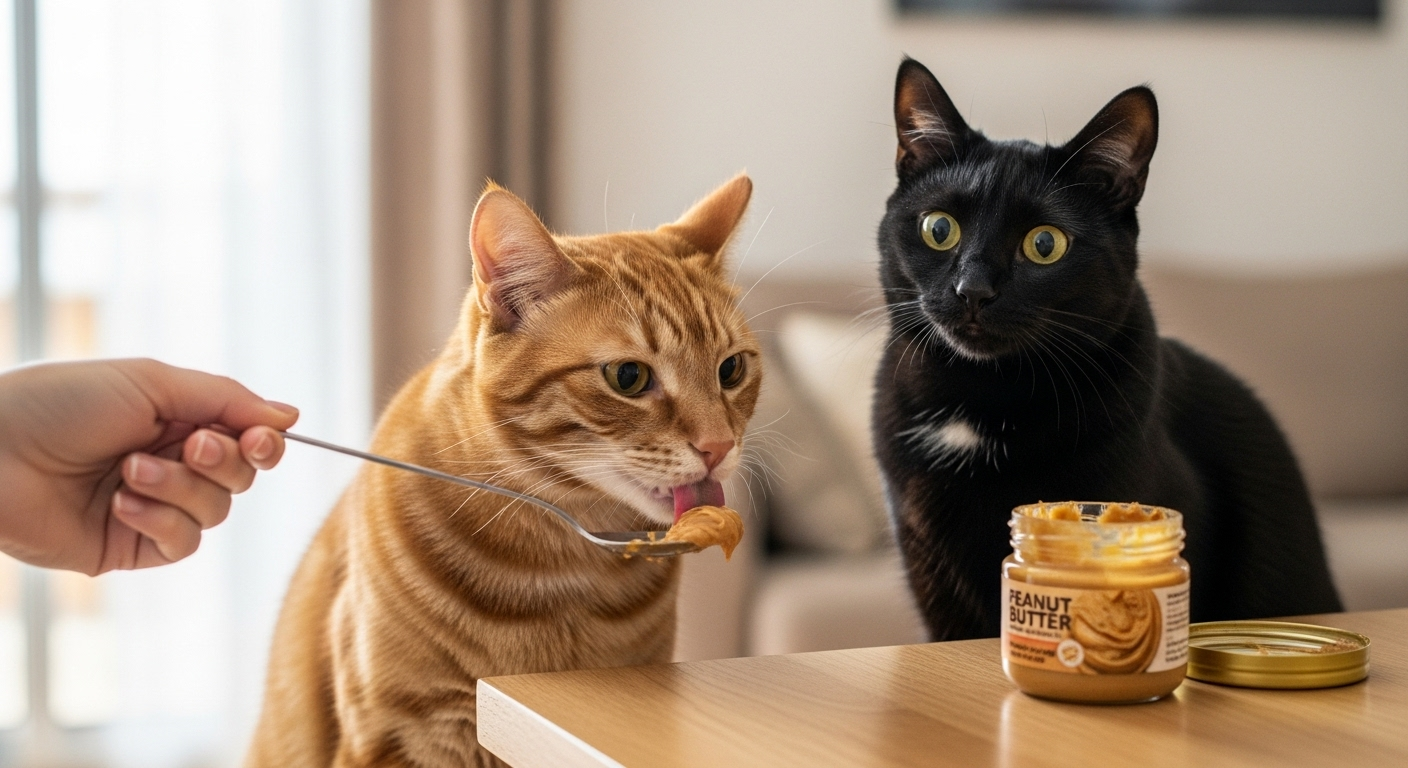
If you absolutely must use peanut butter — for example, to sneak in medication — portion control is critical.
- Recommended maximum: 1/8 to 1/4 teaspoon, and only occasionally.
- Calories: Remember that a single teaspoon of peanut butter has about 30 calories. For an average 10-pound indoor cat, that’s a significant portion of their 200–250 daily calories.
- Frequency: No more than once or twice a week. Peanut butter should never become part of a cat’s routine diet.
⚠️ Important: Always choose a plain, unsalted, unsweetened peanut butter with no xylitol.
Signs Your Cat May Be Reacting Badly
Even a small amount of peanut butter can cause problems in sensitive cats. Watch closely for:
- Vomiting or diarrhea
- Gas and bloating
- Lethargy or weakness
- Itchy skin or excessive scratching
- Coughing, gagging, or signs of choking
- Seizures (if xylitol ingestion is suspected)
If you notice any of these symptoms, contact your veterinarian right away.
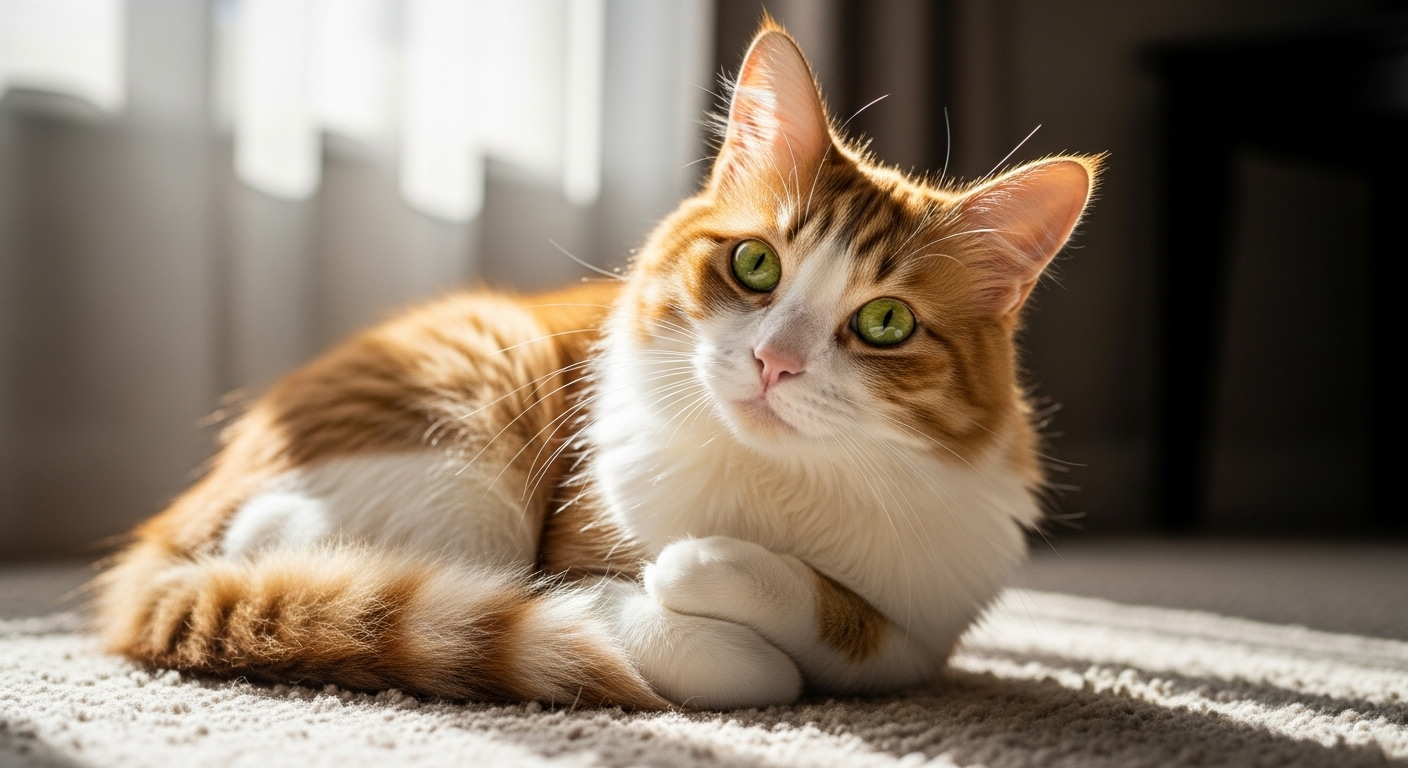
Real-Life Experiences from Cat Owners
Not every cat reacts the same way.
- One cat owner shared that their male cat loved peanut butter on toast and begged for it daily, while his sister refused it completely.
- Another noted that their cats turned up their noses at peanut butter but would happily devour shredded chicken or tuna.
These anecdotes highlight an important truth: cats are individuals with unique tastes. But just because your cat enjoys something doesn’t mean it’s healthy.
Safer Alternatives to Peanut Butter
Instead of risking your cat’s health with peanut butter, consider these cat-safe treats:
- Cooked Chicken or Turkey
- Plain, no seasoning.
- High in protein, aligns with feline dietary needs.
- Cooked Fish (like salmon or tuna, in moderation)
- Rich in omega-3 fatty acids for a shiny coat.
- Avoid raw fish and watch out for bones.
- Freeze-Dried Meat Treats
- Convenient, nutrient-dense, and formulated for pets.
- Commercial Cat Treats
- Specifically designed to balance nutrition and safety.
- Catnip or Cat Grass
- Non-food treats that stimulate enrichment and play.
- Interactive Treat Toys
- Turn snack time into a game for added mental stimulation.
👉 These options not only satisfy your cat’s curiosity but also align with their biological needs as obligate carnivores.
When Peanut Butter Might Be Acceptable
While it’s not recommended as a treat, peanut butter can have one limited use:
- Pill administration. If your cat absolutely refuses other methods, a smear of safe peanut butter can sometimes help. But always ask your vet first, and use the smallest possible amount.
What Happens If a Cat Eats Peanut Butter Accidentally?
It’s not uncommon: you leave a peanut butter sandwich unattended, and your curious cat sneaks a lick. Should you panic?
The good news is that a tiny taste usually isn’t dangerous — as long as the peanut butter is free from xylitol and other harmful additives. However, that doesn’t mean it’s harmless. Cats may still experience:
- Mild stomach upset (vomiting or diarrhea)
- Temporary loss of appetite
- Difficulty swallowing if the texture sticks in their throat
If your cat ate a larger amount or the brand contains xylitol, it’s an emergency. Xylitol poisoning can trigger seizures, hypoglycemia, and even liver failure in cats.
When to Call the Vet
You should contact your veterinarian immediately if your cat shows any of these signs after eating peanut butter:
- Repeated vomiting or diarrhea
- Gagging, choking, or trouble breathing
- Excessive drooling or pawing at the mouth
- Lethargy, weakness, or collapse
- Seizures or loss of coordination
If you suspect xylitol ingestion, don’t wait — call your vet or the Animal Poison Control Center right away.
FAQs About Cats and Peanut Butter
1. Can cat have peanut butter safely?
Technically yes, but they shouldn’t. The risks outweigh any enjoyment, and cats don’t benefit nutritionally.
2. Is peanut butter toxic to cats?
Not inherently, but peanut butter with xylitol is extremely toxic. Other ingredients like sugar, salt, and oils can also harm cats over time.
3. How much peanut butter is safe for cats?
If absolutely necessary (for example, to hide medicine), a pea-sized amount of plain, unsalted, xylitol-free peanut butter is the maximum.
4. Can cats eat peanuts?
Not recommended. Whole peanuts can be a choking hazard, cause digestive upset, and are calorie-dense with little nutritional benefit for cats.
5. What’s a healthier alternative to peanut butter for cats?
Cooked chicken, turkey, or fish, freeze-dried meat treats, or commercial cat treats designed specifically for feline health.
A Personal Note: Lessons Learned
When I was younger, one of my cats loved peanut butter toast mornings with my family. He would sit patiently, eyes locked on the plate, and happily lick a small piece when offered. His sister, though, wouldn’t touch it.
It was a reminder that cats have their own personalities and food preferences — but it also taught me something important: just because a cat likes a food doesn’t mean it’s good for them. That’s why I eventually stopped offering peanut butter, no matter how curious my cats seemed.
Final Thoughts: Can Cat Have Peanut Butter?
So, can cat have peanut butter? Yes — but they really shouldn’t. While it isn’t instantly toxic in small amounts, peanut butter has no nutritional benefit for cats and poses several risks: choking, obesity, allergies, digestive upset, and even life-threatening poisoning if xylitol is present.
The safest choice? Skip the peanut butter and opt for healthier, meat-based treats or vet-approved snacks that align with your cat’s carnivorous needs.
Your cat may beg for a taste, but remember: as a pet parent, your job is to choose what’s best for their long-term health — not just what satisfies their curiosity in the moment.

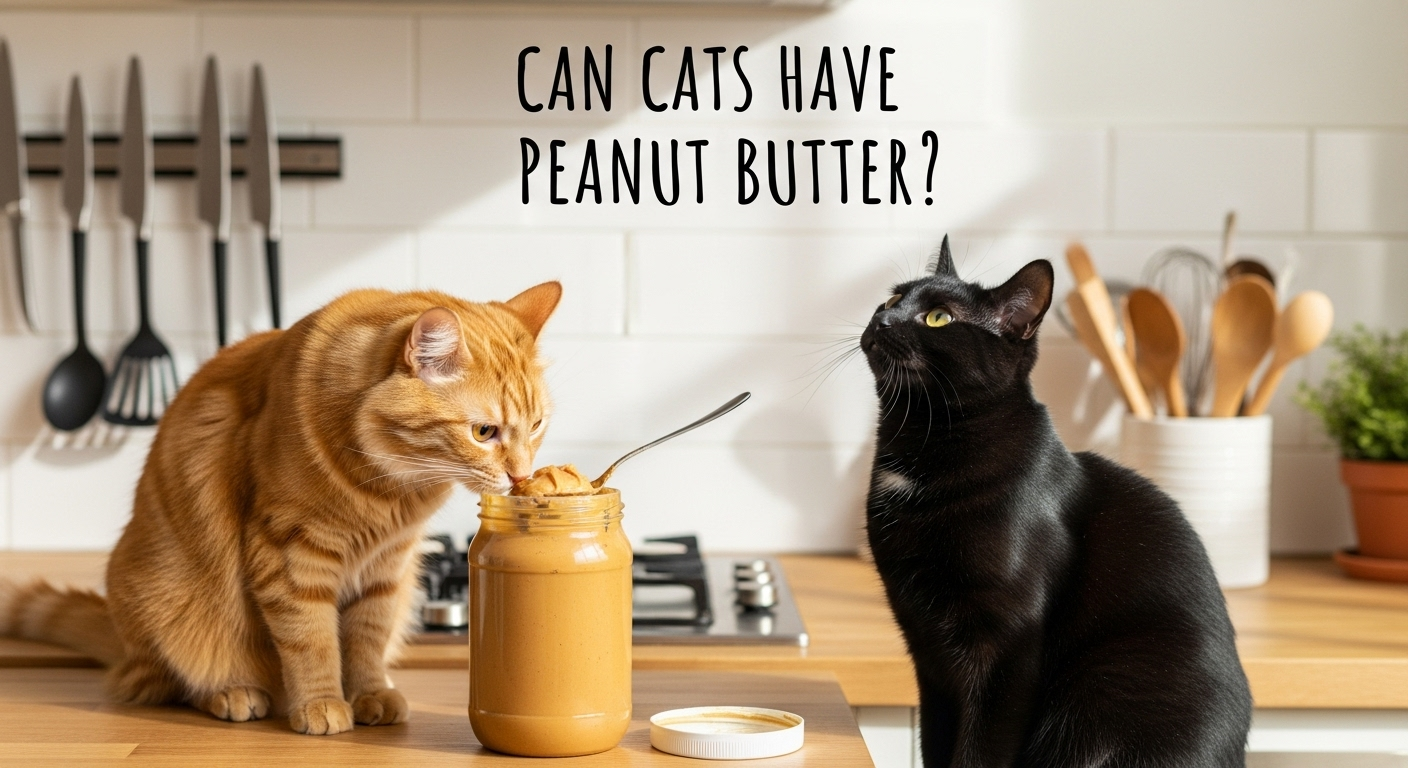
1 thought on “Can Cat Have Peanut Butter? Risks, Safety & Alternatives”